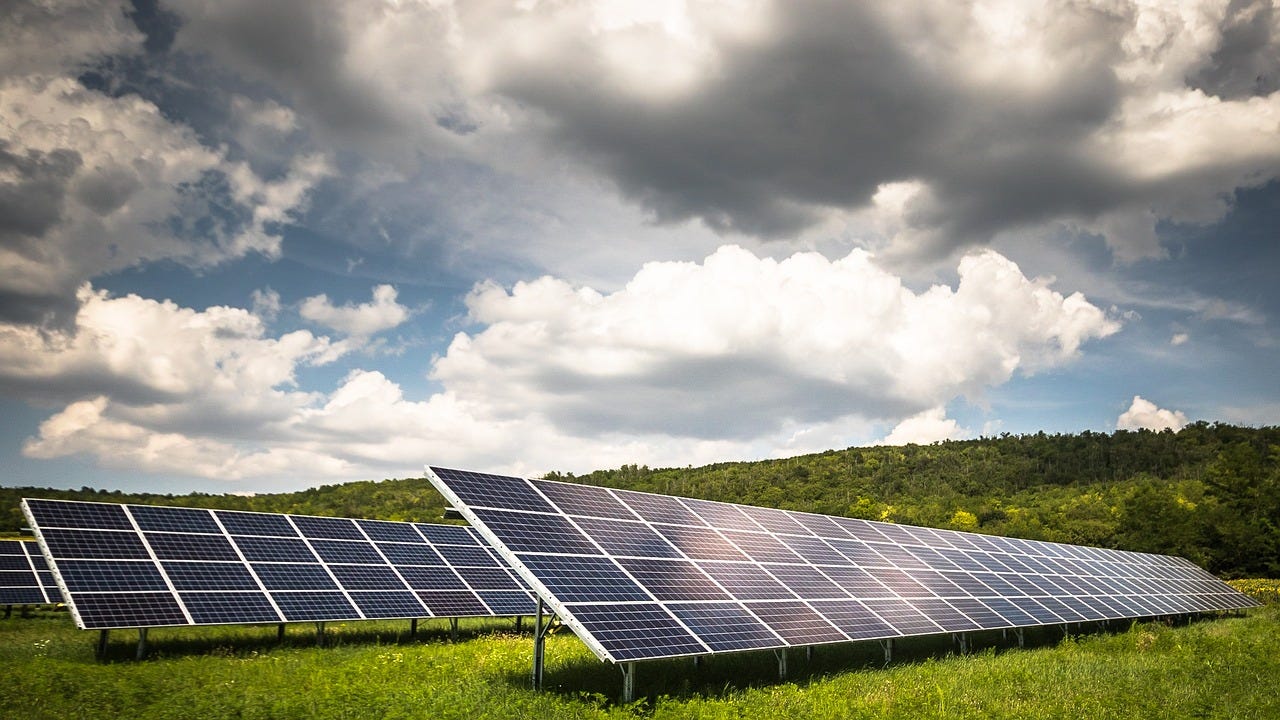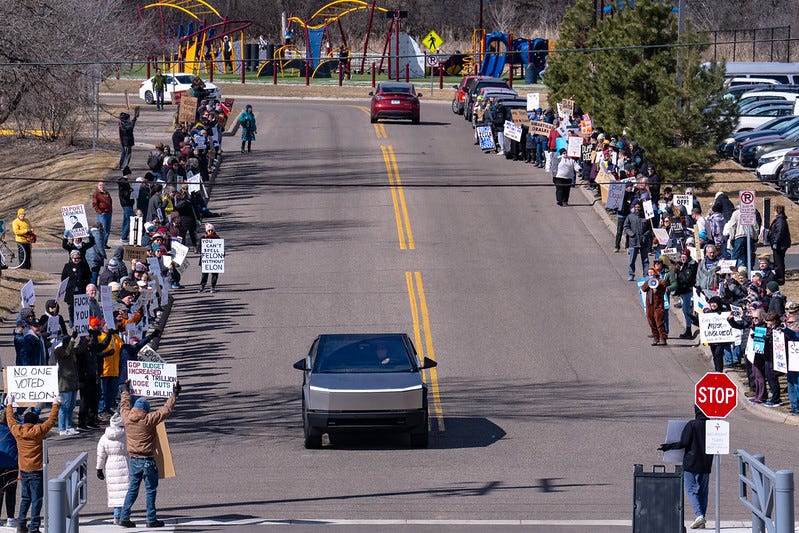Renewables, data center plans, caught in new Trump bear market
Welcome to Callaway Climate Insights, your guide to global climate finance. Please enjoy and share with your colleagues.
Today’s edition of Callaway Climate Insights is free for all our readers. We really want to bring you the best and latest in climate finance from around the world. Please subscribe now.

The global collapse in stocks on Thursday — entirely predictable by all but one man — will be particularly harsh on the renewable energy industry, but also is spreading pain to the traditional energy business just as the economy needs it most.
Renewable energy products run in large part on the strength of their global supply chains; from turbines for wind farms to solar panels to precious minerals for battery storage start-ups. Just as these companies begin to get over the supply chain shocks of the Covid era, the new tariffs will slow things down again.
Nobody, least of all President Donald Trump, has a clear idea of where this is going. But as long as the tariffs are in place the only certain thing is that all economies, and mostly the U.S., will suffer. Liberation Day indeed.
It is possible that by next week the administration will start doing deals and carve outs with individual countries to alleviate the devastation, but this week buried in the carnage was another ominous headline. Bloomberg reported that amid the uncertainty, Microsoft MSFT 0.00%↑ has begun delaying or pausing construction on planned data centers around the world.
The idea that Big Tech will need abundant energy — including renewable energy — to power fleets of new data centers to contend with the coming AI revolution, has been the lynchpin of the stock market’s bull case for the past three years. If this theme is beginning to unwind, for whatever reason, then tech valuations will need to dramatically come down and the market’s current levels will become the norm.
It’s hard to be optimistic in the face of such self-inflicted economic turmoil, but disciplined investors will draw on the hard-earned market history that when everybody else is selling there are great values to be had, and that economic expectations can change with the next headline.
Don’t forget to contact me directly if you have suggestions or ideas at dcallaway@callawayclimateinsights.com.
Follow us . . . .
Twitter | LinkedIn | Facebook | Instagram
Thursday’s subscriber insights
France shifts to higher gear on renewables as U.S. retreats
. . . . As the U.S. retreats from the global climate stage and cuts grants to U.S. projects sustainable projects, Europe is stepping up to show that the fight to decarbonize economies is still alive and well.
This week, L’Oreal, the French cosmetics company, said it has managed in just five years to achieve 100% usage of renewable energy to power its operations in Europe, which represents about half its global factories and distribution centers.
And French energy giant TotalEnergies said today it has expanded its wind and solar capacity in Canada, Germany and Africa with acquisitions from renewables giant RES in Canada and of Germany company VSB, which does business in Africa.
The acquisitions are part of a growing trend among some major energy providers to take advantage of depressed prices in solar, and especially wind, in recent months to make acquisitions for future growth. The activity represents a bet that far from being dead, the economic transition to cheaper and safer renewable energy continues.
Breaking: And speaking of Europe, please spare a thought for Deutsche Bank, President Trump’s bank of choice back in the 1980s and ‘90s, which this week got hit by German authorities with a $27 million fine for greenwashing, associated with a 2022 investigation. At a time when global banks are furiously backpedaling on their green agendas, a fine for greenwashing must be particularly embarrassing.
Hulbert: What Tesla’s fall from grace can teach investors
. . . . For years, debate has raged among climate investors about the effectiveness of divestment of a company’s stock, and whether it will send a message to management more than perhaps, a boycott of its products. But the astonishing impact of a political boycott of Tesla products in the past two months, writes Mark Hulbert, answers that question once and for all. Even with Tesla TSLA 0.00%↑ shares down as much as 40% since Inauguration Day, it was the protests at Tesla dealers and boycotts of its products in Europe and parts of the U.S. that actually caused it. The story serves as an example that product boycotts work better than divestment.
Your daily Elon
The drumbeat of speculation that Elon Musk will soon leave the Trump administration grew louder on Wednesday. And voila, Tesla shares were up that day, even though it reported deliveries fell 13% in the first quarter. Could investors send a stronger signal? Shares fell as much as 5.5% on Thursday along with the rest of the market.
Editor’s picks: Magnetocaloric cooling; plus, peak bloom
Watch this video from DW’s Planet A program: For decades, refrigeration tech has stayed the same — energy-hungry and reliant on harmful gases. Enter magnetocaloric cooling: a new solution claiming to be 30% more energy-efficient than current cooling systems. And it’s scalable. From fridges to cooling buildings and server farms. Deutsche Welle, or DW, is a German public, state-owned international broadcaster.
Iconic cherry trees blooming earlier
The EPA estimates that more than 1.5 million people come to Washington, D.C. every year to enjoy the peak blooming during the National Cherry Blossom Festival. They probably should start making their travel reservations earlier. For the seventh year in a row, the trees have reached peak bloom (when 70% of the Yoshino Cherry blossoms are open) earlier than average, says the National Mall and Memorial Parks/National Park Service, the agency that cares for the Washington Monument, Lincoln Memorial and more. The NPS announced peak bloom about a week ago. ABC News reports 2025 marks the seventh consecutive year that peak bloom has occurred earlier than the April 3 average. It’s also the sixth year in a row with a March peak bloom date. The report cites the Fifth National Climate Assessment as saying climate change is causing seasonal shifts, including milder winters and earlier springs, contributing to the change in peak bloom dates.
Latest findings: New research, studies and projects

Flood protection infrastructure pays off
Flood protection infrastructure investments, such as Army Corps of Engineers levees, can enhance resilience to flood risks amplified by climate change, write the authors of this NBER working paper titled Private Benefits from Public Investment in Climate Adaptation and Resilience. They estimate levees’ benefits by exploiting repeat residential property transactions. In areas protected by levees, home values increase 3 to 4%. Levees impose adverse spillover flood risks that reduce home values in nearby areas by 1 to 5%. Capitalized benefits in protected areas are progressive, but adverse spillover impacts are regressive. Capitalized benefits at levee construction do not vary by race, but racial sorting occurs post-construction. The local political economy of levee construction can explain the distribution of winners and losers. Authors: Jacob Bradt, University of Texas at Austin; Joseph E. Aldy, Harvard Kennedy School; National Bureau of Economic Research; Resources for the Future
More of the latest research:
Words to live by . . . .
“April hath put a spirit of youth in everything.” — William Shakespeare.
Also…
“April is the cruellest month.” — T.S. Eliot.




